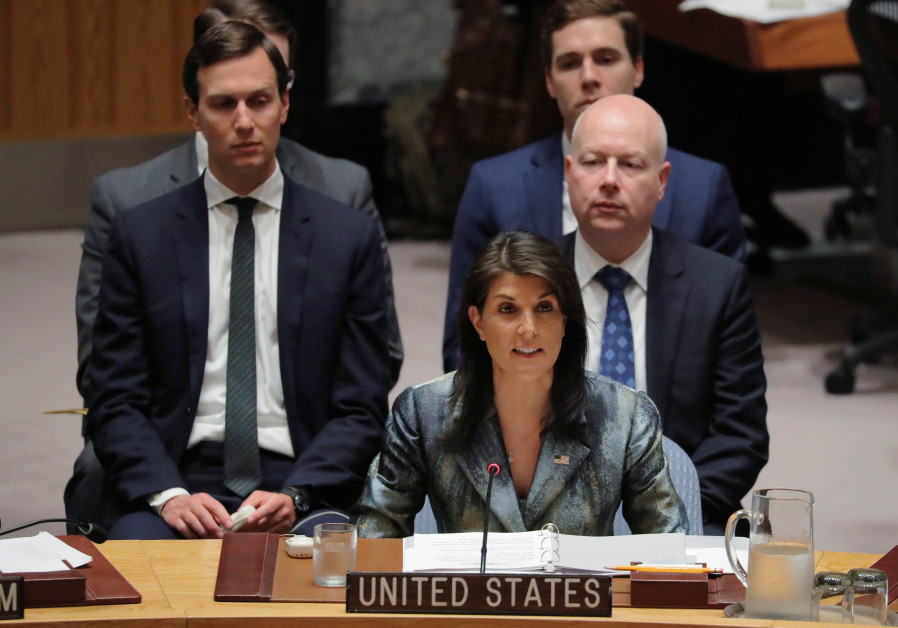Analysis: Where is Trump’s Israeli-Palestinian peace plan?
مايكل ولنر من الجيرازلم بوت: أين أصبحت خطة ترامب للسلام الفلسطيني الإسرائيلي؟
Michael Wilner/Jerusalem Post/August 10/18
In testing whether time is right for a rollout, the administration may be releasing both false and genuine trial balloons to gauge a response.
US President Donald Trump’s plan for Israeli-Palestinian peace may be the most closely guarded policy secret in Washington these days, 18 months in the making and yet still known only to the small handful of men behind it.
Senior administration officials describe the plan as detailed, pragmatic, and essentially complete. All that prevents them from publishing it is their sense that the timing is off.
They are waiting for some ripe moment to present itself – perhaps when the Palestinian leadership decides to give the administration a second chance after writing it off for recognizing Jerusalem as Israel’s capital last year. But such a moment seems unlikely any time soon. The Palestinian Authority, which has not seen the plan, says that Trump’s peace team has given every indication that its contents will reflect bias in favor of Israel by sidestepping explicit references to a two-state solution, dismissing refugee claims, endorsing a permanent Israeli presence in the Jordan Valley, allowing Jewish settlers to remain in the West Bank and remaining silent on the future placement of a sovereign Palestinian capital.
There are reasons to believe they are right. While the White House insists that its recognition of Jerusalem as Israel’s capital does not predetermine sovereignty over the entire city in an eventual peace agreement, it has never explicitly stated, as it did with Israel in December, that Palestinians have a reciprocal right to a capital in the holy city – or to any capital at all.
They have removed all reference to a two-state solution, to Palestinian independence or Palestinian territories from State Department language, dismissing those terms as “meaningless” without yet spelling out alternatives. And they have defunded the UN Relief and Works Agency, characterizing the Palestinian aid organization as a corrupt and inefficient body perpetuating a false narrative on refugees unhelpful to the pursuit of peace.
“The traditional core issues are essential and we focus on them extensively with a strong appreciation of the historic differences between the two sides,” Jared Kushner, the president’s son-in-law and senior adviser leading the peace effort, told the Palestinian Al-Quds newspaper in June. “We are committed to finding a package of solutions that both sides can live with.”
But, he added: “Simply resolving core issues without creating a pathway to a better life will not lead to a durable solution.”
Kushner and Jason Greenblatt, the president’s special representative for international negotiations, have said their plan tackles some of the thorniest issues in the conflict with specificity and ingenuity – a truly novel take on a geopolitical challenge that has, for too long, been mired in stale thinking. But while past efforts have failed, the careful balance American presidents have walked in since 1967 has allowed them to bring both sides around the same table, to the precipice of an agreement multiple times. Trump’s approach thus far has not. The reason the timing has been off may be because the approach is off.
TRUMP’S TEAM says that the PA leadership is prejudging what is in their plan before they see it, and this much is true: Palestinian officials, like the rest of us, have been left to read tea leaves based on the behavior they have seen thus far. If the plan includes revelatory material that defies expectations – as the team claims – then it should not wait for a moment of kindness from the Palestinians to present itself before releasing the plan. That moment will be created by the presentation of the plan.
The peace team seems to be considering this approach, expressing confidence that their work will see the light of day whether or not the Palestinians come around beforehand. They say the plan will include proposals that both parties will love and hate, and lament that they are frequently forced to dismiss rumors on the contents of their plan that scatter news reports.
But in testing whether the time is right for a rollout, the administration may be releasing trial balloons – based both on false as well as genuine tidbits from the plan – to gauge public response, knowing full well it can simply deny whichever ones float too high. Regardless of the strategy, public response has been self-evident as the plan is still under wraps.
Palestinian leaders are skeptical Trump’s team will ever support a policy that disadvantages Prime Minister Benjamin Netanyahu, and at some point, it will have to prove them wrong to earn their trust back. And a report in Foreign Policy magazine last week, which quoted Kushner from back in January questioning the role of UNRWA, did them no favors. White House officials said it was a stretch to say they were denying the refugee status of millions of Palestinians simply by challenging UNRWA’s mandate, which treats the descendants of refugees from the 1940s the same as their modern-day ancestors. But Palestinian leaders saw Kushner’s comments in an e-mail calling for the “disruption” of UNRWA as further evidence of his plans to erode Palestinian claims to a homeland there.
There is one new sign the administration is working on a rollout with direction and purpose. The Associated Press reported last week that the peace team had begun staffing up, on-loading officials from the State Department and National Security Council to create working groups on the policy dimensions of the plan, the economic components of the plan and the strategic sale of the plan to the public. The formation of these teams would indicate that a release is not imminent – these staffers still need time to get into place and prepared – but that publication could be ready in the coming months.
“You can’t put something out where everybody says, ah, this is dead on arrival,” a senior administration official told The Jerusalem Post in June. “You can’t do that. And the same exact document that may be dead on arrival on a Monday might not be dead on arrival on a Thursday. That sounds kind of counterintuitive, but that’s the way this works.”




















